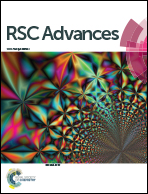The influence of L ligands on the {RuNO}6/7 bonding situation in cis-[Ru(NO)(NO2)L1–4]q complexes: a theoretical insight†
Abstract
It is regularly claimed that equatorial and axial ligands have a crucial role on the release of nitric oxide in ruthenium nitrosyl complexes. The reactivity of NO is dependent not only on the nature of the coordinated ligands but also on the bonding linkage isomerism that it can be involved. In this work, the interplay between the π-acceptor character of different L ligands and its effect on the Ru–NO bonding situation in {RuNO}6 and {RuNO}7 cores of cis-[Ru(NO)(NO2)L1–4]q complexes, where L = ammonia, 2,2′-bipyridine, 1,10′-phenanthroline and 1,4,8,11-tetraazacyclotetradecane ligands, is presented. The Ru–NO bonding situation is studied by the energy decomposition analysis of Su and Li, QTAIM and NBO methods. The nitrosyl–isonitrosyl isomerism is also investigated. Results show that complexes containing strong π-acceptor ligands (2,2′-bipyridine and 1,10′-phenanthroline) have their Ru–NO and Ru–ON interactions stabilized prior the NO reduction, while complexes containing weak π-acceptor ligands (ammonia and 1,4,8,11-tetraazacyclotetradecane) stabilize those interactions after reduction.
![Graphical abstract: The influence of L ligands on the {RuNO}6/7 bonding situation in cis-[Ru(NO)(NO2)L1–4]q complexes: a theoretical insight](/en/Image/Get?imageInfo.ImageType=GA&imageInfo.ImageIdentifier.ManuscriptID=C5RA10888H&imageInfo.ImageIdentifier.Year=2015)

 Please wait while we load your content...
Please wait while we load your content...